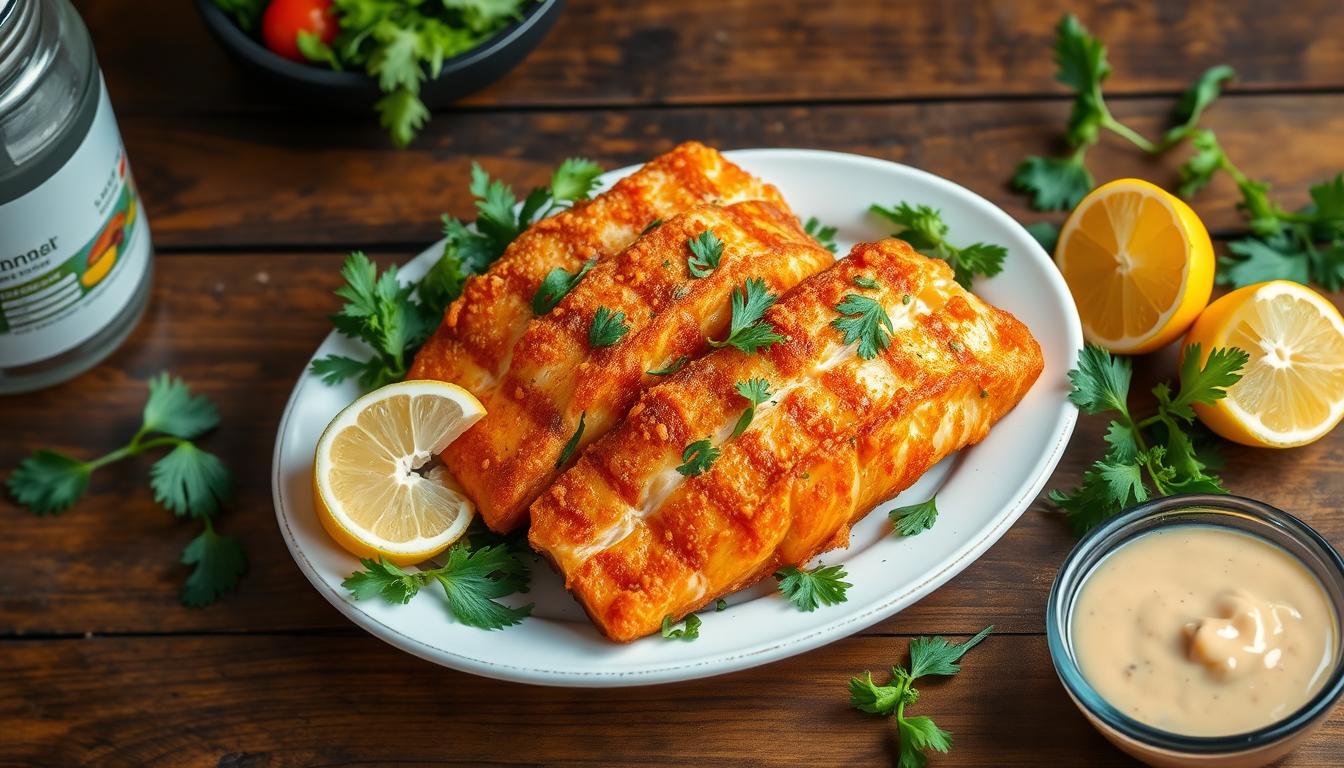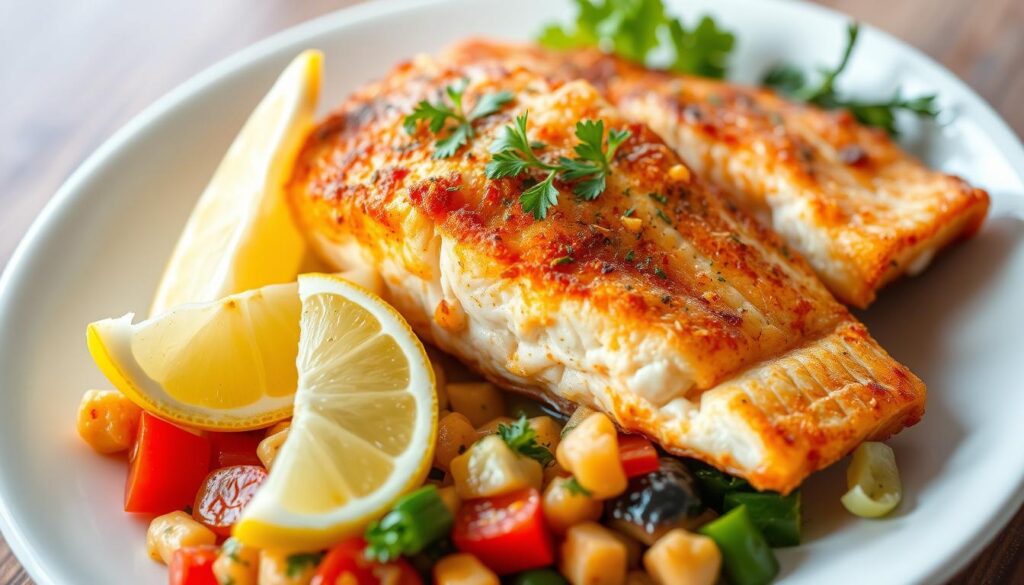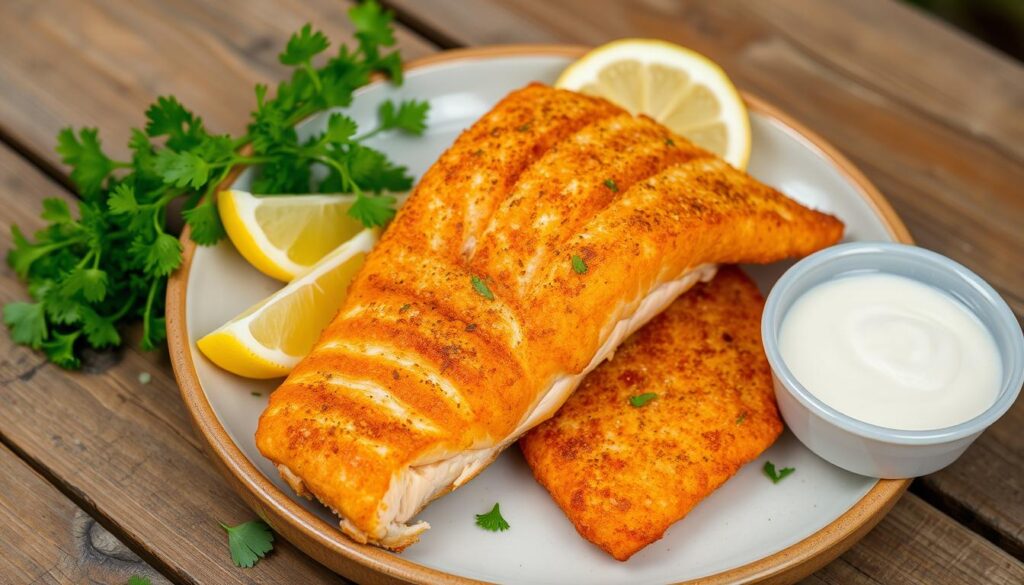introduction:
Deep-frying salmon can be tasty and crispy. But, it’s important to think about its health effects. Is salmon good to deep fry? It depends on the oil and cooking method used.
Deep-frying fish is common, but salmon isn’t the best choice because of its thickness. Yet, you can make deep-fried salmon healthier by choosing the right oil and cooking it right. So, yes, salmon can be good to deep fry if done properly.
Key Takeaways
- Deep-frying salmon can be a healthy choice if done correctly
- Using the right oil and cooking techniques is essential for healthy deep-fried salmon
- Salmon is a popular fish species, with approximately 3 pounds consumed per year in the United States
- Deep fried salmon can be a delicious and crispy dish, but it’s essential to consider the nutritional implications
- Wild-caught salmon tends to have a stronger flavor and firmer flesh compared to farm-raised salmon
- Salmon is packed with protein, vitamin B12, vitamin D, potassium, and selenium, in addition to fatty acids like omega-3s
- Deep-frying salmon can affect its nutritional content, so it’s important to cook it correctly to retain its health benefits
Understanding Salmon as a Protein Source
Frying salmon is a great way to get protein and omega-3s. A 100g serving has 232 kcals, 25.2g protein, and 14.6g fat. It also has vitamins and minerals like vitamin D and selenium.
Choosing the right salmon is key. Wild-caught salmon has more omega-3s than farmed. Pacific salmon is firmer and tastes bolder. Farmed Atlantic salmon is milder and softer.
Salmon is good for your heart and brain. It can lower blood pressure and cholesterol. It’s also full of vitamin D, B vitamins, and zinc.
- High-quality protein for muscle development and immune function support
- Rich in omega-3 fatty acids for heart health and brain function
- Good source of vitamin D and selenium for overall health
Choosing the right salmon and following tips can make a tasty, healthy meal. Salmon is great for heart health and adding protein to your diet. With its many benefits and types, salmon is a fantastic choice for any meal.
| Salmon Type | Omega-3 Fatty Acids | Protein Content |
|---|---|---|
| Wild-caught Salmon | Higher levels | 25.2g per 100g serving |
| Farmed Salmon | Lower levels | 20-25g per 100g serving |
Deep Frying: The Basics
Deep frying salmon is a favorite cooking method. It creates a crispy, golden-brown outside and a tender, flaky inside. To get this, you need to know the basics of deep frying.
Deep frying means cooking food in hot oil. It’s quick and easy. But, you need the right oil and techniques for crispy fried salmon. The best temperature for frying fish is between 350° F to 375° F or 175° C to 190° C.
Here are some common cooking oils for frying:
- Vegetable oil
- Canola oil
- Peanut oil
To fry salmon well, keep the oil temperature steady. Also, use the right seasonings to boost the flavor. With the right methods and ingredients, you can make tasty crispy fried salmon for any event.
By following these basics and using the right ingredients, you can make a dish that will wow everyone. Deep frying salmon is a great skill for both experienced chefs and beginners.
| Oil Temperature | Cooking Time |
|---|---|
| 350° F – 375° F | 1-2 minutes for bite-size pieces |
Health Implications of Deep Frying Salmon
Deep frying salmon can change its nutritional value. It can lose some omega-3 fatty acids. But, using the right oil and cooking methods can help keep more nutrients.
For frying salmon, oils like avocado or grapeseed work well. They have a high smoke point, which helps preserve nutrients.
A 3-ounce serving of fried salmon has about 300 calories and 20 grams of fat. Even though it’s high in fat, salmon is full of omega-3s. These are good for your heart. The National Institute for Health suggests eating fish twice a week for omega-3 benefits.
- Use a thermometer to ensure the oil reaches the correct temperature.
- Don’t overcrowd the pot, as this can lower the oil temperature.
- Drain excess oil from the fried salmon using paper towels.
| Fish Type | Calories per 3-ounce serving | Fat per 3-ounce serving |
|---|---|---|
| Fried Cod | 200 | 10g |
| Fried Salmon | 300 | 20g |
By following these tips, you can enjoy fried salmon. It’s tasty and nutritious, with fewer health risks.
Flavor Profile of Deep-Fried Salmon
Deep-fried salmon has a great flavor mix. It’s crispy on the outside and soft on the inside. You can use seasonings like lemon pepper, garlic powder, or paprika to enhance the taste. The goal is to match the seasonings with the salmon’s natural flavor.
Getting the salmon crispy can be tricky. But, using a light batter or breading helps. This way, the outside gets crunchy, and the inside stays moist and tasty. Remember, don’t overcook the fish to avoid dryness.
The Ideal Seasonings for Fried Salmon
Some top seasonings for fried salmon are:
- Lemon pepper
- Garlic powder
- Paprika
- Dill weed
These seasonings add a lot of flavor without hiding the fish’s taste.
Texture Changes After Frying
Frying salmon changes its texture a lot. The outside gets crispy and golden, while the inside stays tender. To get the best texture, fry the fish for 3 to 5 minutes per batch. Make sure it reaches an internal temperature of 145°F.
Cooking Techniques for Deep-Frying Salmon
Deep-frying salmon right is key to a crispy outside and a soft inside. First, pat the salmon dry and season it with herbs and spices. This step removes excess moisture, allowing the oil to cook the fish evenly.
The frying temperature is also critical. It should be between 350°F and 375°F. Too hot, and the outside burns before the inside cooks. Too cold, and the fish will be greasy or undercooked. Use a thermometer to keep the oil at the perfect temperature.
Deep frying salmon has many benefits. It makes the fish crispy on the outside and tender on the inside. You can also add different seasonings and herbs to make it taste better. Here’s how to deep fry salmon:
- Heat the oil to the recommended temperature
- Pat the salmon dry and season with herbs and spices
- Carefully place the salmon in the hot oil
- Cook for 3-5 minutes on each side, or until golden brown and flaky
| Ingredient | Quantity |
|---|---|
| Salmon fillets | 2 pounds |
| Peanut oil | 1/4 cup |
| Herbs and spices | to taste |
By following these steps and using the right ingredients, you can make a delicious, crispy deep-fried salmon. Always use fresh ingredients and don’t overcrowd the pot. This keeps the oil temperature steady and ensures a great dish.
Alternatives to Deep-Frying Salmon
There are many ways to cook salmon, not just deep-frying. Wild-caught salmon is great for frying because of its rich flavor and health benefits. To get a crispy outside and a soft inside, pick the right cooking method.
Baking vs. Deep Frying: A Comparison
Baking is a healthier choice than deep-frying because it uses less oil. To bake salmon, heat your oven to 400°F (200°C). Season the fish with herbs and spices, and add lemon juice for extra taste.
Grilling or Air Frying: What’s Healthier?
Grilling and air frying are also good alternatives. Air frying makes the outside crispy without much oil. For air frying, use a cornstarch marinade and cook at 400°F (200°C) for 6 minutes. This method makes the salmon crispy and flaky.
Here’s a comparison of the nutritional benefits of each method:
| Cooking Method | Calories | Protein | Fat |
|---|---|---|---|
| Deep-Frying | 350-400 | 30-35g | 20-25g |
| Baking | 200-250 | 35-40g | 10-15g |
| Grilling | 200-250 | 35-40g | 10-15g |
| Air Frying | 242 | 32g | 12g |
Portion Sizes: How Much Salmon is Enough?
Many people wonder why deep fry salmon. The answer is the special texture and taste it gets from deep-frying. To enjoy deep-fried salmon, knowing the right portion sizes is key. A good rule is to serve 3-4 ounces of salmon per person. You can adjust this based on what you like and need.
Here’s what a 3-ounce serving of crispy fried salmon looks like:
| Nutrient | Amount |
|---|---|
| Calories | 210 |
| Protein | 20g |
| Fat | 12g |
A 3-ounce serving of crispy fried salmon is packed with protein and some fat. To make your meal complete, add veggies and whole grains.
Knowing the right portion sizes and balancing your meal helps you enjoy deep-fried salmon. It keeps your diet healthy and balanced.
Deep-Fried Salmon Recipes to Try
Exploring deep-fried salmon recipes is exciting. To start, you’ll need salmon fillets, cooking oil, and a breading mix. A basic recipe uses 4 salmon fillets, each 8 to 10 ounces. This is perfect for individual servings or smaller portions.
To get a crispy outside, heat 1/4 inch of oil in a skillet. Fry the salmon for 5 to 7 minutes on one side. Then, flip and cook for another 5 minutes. You can also use a cornmeal breading mix for a crunchy texture and flavor.
To enhance flavor, top the fried salmon with a tablespoon of butter. This recipe is quick, taking under 30 minutes to prepare. It’s also good for those watching their oil intake. Feel free to try different seasonings like sweet paprika, garlic powder, and chili powder to suit your taste.
Easy Classic Deep-Fried Salmon
This recipe is perfect for beginners. It’s ready in under 35 minutes. Each serving has 493 kcal, with 22g of carbs, 37g of protein, and 28g of fat.
Spicy Deep-Fried Salmon Bites
For a spicy twist, add chili powder or paprika to the breading. This gives your deep fried salmon a bold flavor. You can serve these bites as an appetizer, main dish, snack, or finger food, making it versatile.
Addressing Common Concerns About Deep Frying
Deep frying salmon is quick and easy, but it raises health concerns. It’s important to know how to fry salmon without harming your health. This way, you can enjoy its benefits.
Choosing the right oil is key. Use oils like peanut or sunflower oil, which have high smoke points. Also, change the oil often to avoid harmful compounds. Proper oil disposal is vital for the environment.
To make deep frying healthier, follow some
. Use the right oil, don’t overcrowd the fryer, and don’t overcook the salmon. These steps help you enjoy deep-fried salmon without the downsides.
Some important tips for healthier deep frying include:
- Using oils with high smoke points
- Changing the oil regularly
- Not overcrowding the fryer
- Not overcooking the salmon
By following these tips, you can enjoy deep-fried salmon in a healthy and tasty way. Whether you’re new to deep frying or want to improve, these tips will help you.
The Role of Accompaniments with Deep-Fried Salmon
Choosing the right side dishes is key for deep-fried salmon. You want sides that enhance the crispy, savory taste without taking over. With 52 side dish recipes for salmon, picking the right one can be tough.
Think about the season when picking sides. In summer, a fresh squash with onions and sautéed asparagus is perfect. For fall, crispy roasted Brussels sprouts are a hit. A light option is a fresh orzo salad, great with deep-fried salmon.
Best Side Dishes to Pair
- Lemon-dill vinaigrette side dish, perfect for baked or grilled salmon
- Caesar salad with kale and salmon, featuring a crispy, cheesy topping
- Cabbage wedges with a hot bacon dressing, a delicious and savory option
Complementary Sauces and Dips
A great sauce or dip can boost your deep-fried salmon’s flavor. Try a dipping sauce with soy sauce, mirin, and ginger, used for Salmon Tempura. For something lighter, a lemon-dill sauce adds a refreshing touch to crispy fried salmon.
The Environmental Impact of Salmon Farming
Choosing the best salmon for frying means thinking about its environmental impact. Salmon farming can harm the environment by using too many resources and polluting. It’s important to know the difference between farmed and wild salmon to make a sustainable choice.
When picking salmon, consider the type, its origin, and how it was farmed. For example, Atlantic salmon is often farmed but might harm the environment more than wild-caught salmon. Wild-caught salmon, while more expensive and rare, has a lower environmental impact.
To make good choices, here are some tips for frying salmon:
- Choose salmon from sustainable sources, such as those certified by the Aquaculture Stewardship Council.
- Consider the type of salmon and its origin, as some species may have a lower environmental impact than others.
- Look for salmon that has been farmed using environmentally friendly methods, such as recirculating aquaculture systems.
By following these tips and choosing the best salmon for frying, you can help reduce the environmental harm of salmon farming. This makes your choice more sustainable.
| Salmon Species | Environmental Impact |
|---|---|
| Atlantic Salmon | Higher environmental impact due to farming methods |
| Wild-Caught Salmon | Lower environmental impact, but may be more expensive and harder to find |
Conclusion: Is Deep-Frying Salmon Worth It?
Deciding if deep-frying salmon is good depends on your health goals and taste preferences. Deep frying can lower the fish’s omega-3 content. But, it also makes the salmon crispy and flavorful.
If you decide to deep fry salmon, use good oil and keep the temperature right. Also, eat small portions. Serve it with healthy sides to make a great meal. Remember, deep-fried salmon should be a rare treat, not a regular food.
Final Thoughts on Deep-Fried Salmon
Whether deep-frying salmon is good for you depends on your choices. It’s all about finding a balance between enjoying the taste and keeping it healthy. Knowing the good and bad points helps you make a smart choice.
FAQ
Is salmon good to deep fry?
Salmon can be good for deep frying, but it’s important to think about health. Deep frying can reduce the omega-3 fatty acids in salmon. Yet, with the right methods, deep-fried salmon can be tasty and fulfilling.
What is the best salmon for frying?
For frying salmon, choose a fresh, high-quality fillet. Look for salmon that’s firm, bright, and has little fat. Sockeye or coho salmon work best because they’re firmer and hold up well to frying.
What are some tips for frying salmon?
To fry salmon well, follow these tips. Pat the salmon dry before seasoning and frying to get a crispy exterior. Use hot oil like vegetable or canola, and keep the temperature between 350°F and 375°F. Also, fry in batches to avoid steaming instead of crisping.
Why deep fry salmon?
Deep frying salmon has several benefits. It creates a crispy outside while keeping the inside tender. It’s also faster than baking or grilling. Plus, it offers a rich, indulgent flavor and texture.
How do you make crispy fried salmon?
For crispy fried salmon, follow these steps. Pat the salmon dry and season it well. Use hot oil and fry at 350°F to 375°F. Fry for 2-4 minutes per side until it’s golden and crispy.
How do you deep fry salmon?
To deep fry salmon, start by preparing the fillets. Pat them dry and season as desired. Heat oil to 350°F to 375°F. Fry the salmon for 2-4 minutes per side until golden. Drain on paper towels before serving.
What are the advantages of deep frying salmon?
Deep frying salmon has several advantages. It creates a crispy, flavorful outside while keeping the inside moist. It’s also faster than baking or grilling. Some people enjoy the rich flavor and texture it provides.



